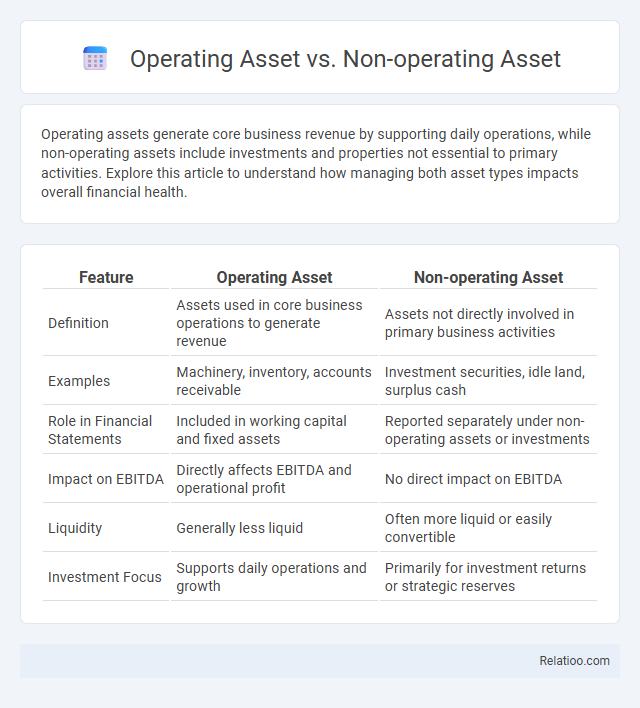Operating assets generate core business revenue by supporting daily operations, while non-operating assets include investments and properties not essential to primary activities. Explore this article to understand how managing both asset types impacts overall financial health.
Table of Comparison
| Feature | Operating Asset | Non-operating Asset |
|---|---|---|
| Definition | Assets used in core business operations to generate revenue | Assets not directly involved in primary business activities |
| Examples | Machinery, inventory, accounts receivable | Investment securities, idle land, surplus cash |
| Role in Financial Statements | Included in working capital and fixed assets | Reported separately under non-operating assets or investments |
| Impact on EBITDA | Directly affects EBITDA and operational profit | No direct impact on EBITDA |
| Liquidity | Generally less liquid | Often more liquid or easily convertible |
| Investment Focus | Supports daily operations and growth | Primarily for investment returns or strategic reserves |
Introduction to Operating and Non-operating Assets
Operating assets are essential resources directly used in a company's core business activities, such as machinery, inventory, and accounts receivable. Non-operating assets include items not directly involved in daily operations, like excess cash, investments, or real estate holdings. Understanding your operating versus non-operating assets helps evaluate true business performance and asset efficiency.
Defining Operating Assets
Operating assets are the essential resources a company uses directly in its core business activities, such as machinery, inventory, and accounts receivable. Non-operating assets include investments or properties not used in daily operations, like marketable securities or idle land. Your understanding of operating assets helps in accurately assessing business efficiency and profitability.
Defining Non-operating Assets
Non-operating assets are assets that a company holds but are not essential to its core business operations, such as investment properties, excess cash, or marketable securities. Operating assets directly support and drive the company's primary revenue-generating activities, including machinery, inventory, and property used in production. Understanding the distinction helps you evaluate a company's operational efficiency and financial health by differentiating between assets that contribute to ongoing business performance and those held for investment or other purposes.
Key Differences Between Operating and Non-operating Assets
Operating assets are essential for Your company's core business operations and directly generate revenue, including items like machinery, inventory, and buildings used in production. Non-operating assets, such as investment properties, marketable securities, and excess cash, do not contribute to daily business activities but can still impact overall financial performance. Understanding the distinction between operating and non-operating assets helps in accurate financial analysis and valuation by separating assets driving operational efficiency from those held for investment or other purposes.
Examples of Operating Assets
Operating assets include machinery, inventory, and accounts receivable, which are essential for your company's daily revenue-generating activities. Non-operating assets consist of investments, unused land, or excess cash that do not contribute directly to core business operations. Understanding the distinction between operating and non-operating assets helps optimize asset management and improve financial performance.
Examples of Non-operating Assets
Non-operating assets are those that a company holds but are not essential for its core business operations, such as investment properties, marketable securities, or idle land. Operating assets include machinery, inventory, and equipment directly used in production or service delivery, while the broader category of assets encompasses both operating and non-operating types. Recognizing non-operating assets helps investors assess a company's true operational efficiency separate from investment or non-core asset performance.
Impact on Financial Statements
Operating assets, such as equipment and inventory, directly contribute to Your company's core business operations and influence key financial statements by affecting revenue generation and operating expenses. Non-operating assets, like investments or idle land, do not impact daily operations but appear on the balance sheet, affecting total asset value and potentially generating non-operating income on the income statement. Understanding the distinction between these assets is crucial for accurate financial analysis, as operating assets drive operational cash flows while non-operating assets impact investment returns and overall financial position.
Importance in Business Valuation
Operating assets, such as machinery, inventory, and accounts receivable, are critical in business valuation because they directly contribute to a company's core revenue-generating activities. Non-operating assets, including excess cash, investments, and real estate unrelated to operations, hold value but typically do not influence the ongoing profitability or cash flow projections used in valuation models. Distinguishing between operating and non-operating assets ensures accurate assessment of enterprise value, enhancing precision in financial analysis and investment decisions.
Managing Operating vs Non-operating Assets
Managing operating assets involves optimizing resources directly tied to your company's core business activities, such as machinery, inventory, and accounts receivable, to enhance efficiency and profitability. Non-operating assets, including investments, real estate, or idle cash, require distinct strategies focused on maximizing returns without impacting day-to-day operations. Effective management of both asset types ensures a balanced financial structure, enabling improved cash flow and strategic growth opportunities.
Conclusion: Strategic Implications for Asset Management
Operating assets directly support core business activities and generate primary revenue, while non-operating assets, such as investments or idle properties, do not contribute to day-to-day operations but may offer financial flexibility or capital appreciation. Effective asset management requires distinguishing these categories to optimize capital allocation, enhance operational efficiency, and improve financial performance. Prioritizing operating asset investments aligns resources with strategic growth, whereas leveraging non-operating assets can provide liquidity and risk diversification.

Infographic: Operating Asset vs Non-operating Asset
 relatioo.com
relatioo.com